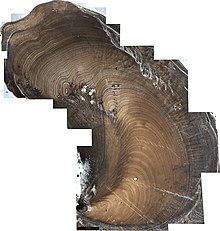| Geoduck | |
|---|---|

| |
| A live specimen of Panopea generosa | |
| Scientific classification | |
| Domain: | Eukaryota |
| Kingdom: | Animalia |
| Phylum: | Mollusca |
| Class: | Bivalvia |
| Order: | Adapedonta |
| Family: | Hiatellidae |
| Genus: | Panopea |
| Species: | P. generosa
|
| Binomial name | |
| Panopea generosa Gould, 1850
| |
The Pacific geoduck (/ˈɡuːiˌdʌk/ GOO-ee-duk; Panopea generosa) is a species of very large saltwater clam in the family Hiatellidae.[1][2] The common name is derived from the Lushootseed name, gʷidəq.
The geoduck is native to the coastal waters of the eastern North Pacific Ocean from Alaska to Baja California.[2] The shell of the clam ranges from 15 centimetres (6 in) to over 20 centimetres (8 in) in length, but the extremely long siphons make the clam itself much longer than this: the "shaft" or siphons alone can be 1 metre (3 ft 3 in) in length. The geoduck is the largest burrowing clam in the world.[3] It is also one of the longest-living animals of any type, with a typical lifespan of 140 years;[4] the oldest has been recorded at 179 years old.[5] The precise longevity of geoducks can be determined from annual rings deposited in the shell which can be assigned to calendar years of formation through crossdating.[6][7] These annual rings also serve as an archive of past marine variability.[5][8][9]

- ^ Panopea generosa Gould, 1850. Retrieved through: World Register of Marine Species on 28 December 2010.
- ^ a b Cite error: The named reference
Vadopalaswas invoked but never defined (see the help page). - ^ Morgan, James (19 July 2015). "The 'phallic' clam America sells to China". BBC. Retrieved 20 July 2015.
- ^ Orensanz, J. M. L.; Hand, C. M.; Parma, A. M.; Valero, J.; Hilborn, R. (2004). "Precaution in the harvest of Methuselahs clams-the difficulty of getting timely feedback from slow-paced dynamics". Can. J. Fish. Aquat. Sci. 61 (8): 1355–1372. doi:10.1139/f04-136.
- ^ a b Edge, David; Reynolds, David; Wanamaker, Alan; Griffin, Daniel; Bureau, Dominique; Outridge, Christine; Wang, Richard; Stevick, Bethany; Black, Bryan (2021). "Multicentennial Proxy Record of Northeast Pacific Sea Surface Temperatures From the Annual Growth Increments of Panopea generosa". Paleoceanography and Paleoclimatology. 36 (9). Bibcode:2021PaPa...36.4291E. doi:10.1029/2021PA004291. S2CID 239151578. Retrieved 13 September 2022.
- ^ Kastelle, Craig R.; Helser, Thomas E.; Black, Bryan A.; Stuckey, Matthew J.; C. Gillespie, Darlene; McArthur, Judy; Little, Diana; D. Charles, Karen; Khan, Reziah S. (15 October 2011). "Bomb-produced radiocarbon validation of growth-increment crossdating allows marine paleoclimate reconstruction". Palaeogeography, Palaeoclimatology, Palaeoecology. 311 (1): 126–135. Bibcode:2011PPP...311..126K. doi:10.1016/j.palaeo.2011.08.015.
- ^ Black, Bryan A.; Gillespie, Darlene C.; MacLellan, Shayne E.; Hand, Claudia M. (December 2008). "Establishing highly accurate production-age data using the tree-ring technique of crossdating: a case study for Pacific geoduck (Panopea abrupta)". Canadian Journal of Fisheries and Aquatic Sciences. 65 (12): 2572–2578. doi:10.1139/F08-158.
- ^ Black, Bryan A.; Copenheaver, Carolyn A.; Frank, David C.; Stuckey, Matthew J.; Kormanyos, Rose E. (15 July 2009). "Multi-proxy reconstructions of northeastern Pacific sea surface temperature data from trees and Pacific geoduck". Palaeogeography, Palaeoclimatology, Palaeoecology. 278 (1): 40–47. Bibcode:2009PPP...278...40B. doi:10.1016/j.palaeo.2009.04.010.
- ^ Strom, Are; Francis, Robert C.; Mantua, Nathan J.; Miles, Edward L.; Peterson, David L. (March 2004). "North Pacific climate recorded in growth rings of geoduck clams: A new tool for paleoenvironmental reconstruction: NORTH PACIFIC CLIMATE FROM GEODUCK CLAMS". Geophysical Research Letters. 31 (6): n/a. doi:10.1029/2004GL019440. S2CID 15853307.